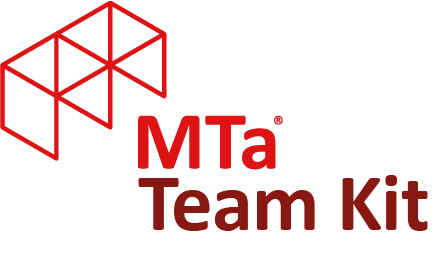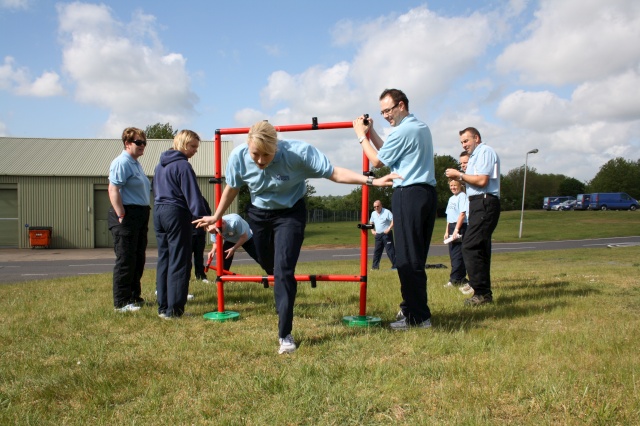Bring Lencioni team dynamics to life with MTa experiential activities
Part of our series on bringing theories to life with experiential learning. Read the rest here.
Patrick Lencioni is a prolific author and speaker, most famous for his theories of organisational health, leadership, and team dynamics.
If you’re a facilitator looking to explore team performance, we recommend combining Lencioni’s theories with experiential learning activities that bring team dynamics to life.
In this blog post we’ll share three experiential learning activities from the MTa Team Kit that are ideal for exploring team dynamics within the context of Lencioni’s theories. These activities are designed to bring behaviours to the fore, and to give participants an opportunity to see and understand their contributions to a team, and explore the wider culture of the team..
Here’s what we’ll cover:
- Who is Patrick Lencioni?
- What he is known for
- The five dysfunctions of a team
- Using the MTa Team to bring team dynamics to life
- Over the Bridge – Explore teamwork fundamentals
- Digital Display – Discovery where teams are at each layer of Lencioni’s pyramid
- The Tower – A fun yet powerful activity
Who is Patrick Lencioni?
Patrick Lencioni is a prominent figure in the fields of organisational health and leadership. He has published numerous books on these subjects and is a much sought-after speaker. He is also the founder of a management consulting firm which helps organisations to implement his theories, called The Table Group.
What is Lencioni known for?
Lencioni is known for his theories of organisational health, leadership, and teamwork, and his methods of improving these areas to strengthen organisational culture. His theories have made significant impacts by providing a common language and framework to discuss concepts, alongside practical solutions to improve organisational culture.
His ideas are usually expressed and explored via the business fable medium: a fictional story that shares valuable lessons for those in the business world, and whose fictional nature allows for deep hypothetical exploration.
Some of Lencioni’s most famous books in this format are:
- The Five Temptations of a CEO: A Leadership Fable
- Death by Meeting: A Leadership Fable… About Solving the Most Painful Problem in Business
- The Truth About Employee Management: A Fable About Addressing the Three Root Causes of Job Misery
Lencioni believes improvements in the areas outlined above can give businesses a competitive edge, through the manifestation of qualities like:
-
- Less office politics, meaning fewer distractions from the team’s goals and a more productive set of motivations for members of the team
- More clarity amongst workers, meaning better focus and more purposeful work towards the goals of the team
- Higher morale, leading to less distraction, lower dissatisfaction and a higher likelihood of team members staying focused
- Higher productivity, as a result of the above and of equipping team members with skills they need to function well within a team
Lencioni is perhaps best known for his book “The Five Dysfunctions of a Team.” This book became popular upon its publication in 2002, and continues to attract interest from today.
The Five Dysfunctions of a Team
In this blog post we’ll recommend experiential learning activities that let you explore the five dysfunctions identified by Lencioni in the eponymous book. They are:
- Absence of trust: Without trust, members of a team are less likely to provide input or ask for help for fear of being judged or maybe even ridiculed. When suspicion and self-preservation are prominent dynamics within a team, office politics is more likely to result.
- Fear of conflict: Back and forth is part of a healthy team dynamic, but is made difficult in teams where members are afraid of causing offence or creating tension. Team decision making is easier when members are able to challenge each other’s ideas in a healthy way.
- Lack of commitment: When team members do not feel bought in, they may be less likely to contribute or feel invested in the performance of the team. When ambiguity and confusion are prominent, commitment is less likely.
- Avoidance of accountability: If a team member doesn’t feel committed and is afraid of conflict, they are less likely to hold their peers to account, meaning that suboptimal behaviours, decisions or performance are not challenged.
- Inattention to results: When a team’s performance is held in secondary importance to an individual’s or the organisation’s, team performance is likely to suffer because members will allocate their resource to these other areas.

Discover the MTa Team Kit today
Taking Lencioni’s theories even further
While Lencioni’s books are great for giving those in leadership roles a better understanding of the challenges involved in fostering effective teamwork, the format does not easily allow for the ideas to be explored in situ.
With this in mind, leaders and facilitators are often on the lookout for activities they can run to explore aspects of and challenges around effective teamwork. We recommend experiential learning activities as the type best suited to showing participants how their behaviours contribute to team dynamics, and through structured review, to explore how these behaviours can be changed or better leveraged.
When Lencioni’s common language and framework is combined with experiential learning activities, the stage is set for lasting, impactful change on a personal level as well as the organisational one.
To help participants achieve the benefits outlined earlier, a facilitator needs to use experiential learning activities to create scenarios where behaviours can be put into practice.
Using MTa materials to bring Lencioni’s theories to life
Our experiential learning kits contain activities designed to simulate real-world scenarios that allow participants to observe, consider, discuss and build on their behaviours.
To build on Lencioni’s theories, you’ll need to use activities with a focus on team dynamics and related skills. The activities below are handpicked by our senior facilitator Jamie Thompson, who has delivered experiential learning to some of the biggest companies in the world.
The MTa Team Kit – Built for Team Development
This kit contains 16 activities to develop high-performing teams, all of which are easy to integrate into popular team development models.

The Team Kit is ideal for facilitators who want to explore and develop all aspects of effective team performance. The activities can diagnose team dysfunction, spotlight individual behaviours, and lay the groundwork for discussion, review, and improvement.
Our kits are designed to work with diverse teams, meaning that whatever the maturity of the team you’re working with, there’ll be an activity to fit. The three activities below are from the Team Kit, and give an idea of its strengths and versatility.
Learn more about the MTa Team Kit here or book a demo to see it in action.
Over the Bridge – Explore teamwork fundamentals
This is a classic team activity, fantastic for giving a general sense of how a team is performing in relation to Lencioni’s Five Dysfunctions. With Over the Bridge, you can explore and review the fundamental concepts and skills of team working ahead of a more conceptual exploration later.
By seeing which behaviours are driving the team at a practical level, participants begin to understand how their behaviours contribute to the team dynamic in the context of Lencioni’s theories.
Digital Display – Discover where teams are at each layer of Lencioni’s pyramid
This activity provides an opportunity to explore aspects of teamwork on a more conceptual level. This is the activity we’d most recommend for facilitators looking to explore Lencioni’s Five Dysfunctions.
Here’s how Digital Display functions with reference to each:
- Absence of trust: Without trust participants won’t take risks, and won’t feel vulnerable enough to admit if they’re not sure how to proceed. They won’t innovate and experiment as they don’t trust that these contributions will be respected.
- Fear of conflict: To be successful participants need to give feedback on each other’s efforts, which carries the potential for conflict. If people fear conflict, or cannot communicate without causing conflict, the activity won’t progress.
- Lack of commitment: The activity is ambiguous by design, and contains operational and strategic ambiguity. Unless teams have the resilience to complete the task, they’ll struggle.
- Avoidance of accountability: Participants won’t hold each other sufficiently to account if they fear conflict. This activity involves observation, and in teams where observations of suboptimal choices aren’t raised, the groundwork is not laid for success.
- Inattention to results: It’s very easy for a team member to step back when they have succeeded at the individual level, but this inattention to the results of the team sets everyone up for failure.
The Tower – A fun, yet powerful activity
This activity is an energetic alternative to Digital Display, and is a good choice for facilitators looking for something a little lighter.
The Tower is a more sophisticated version of the Prisoner’s Dilemma, and is at heart a negotiating activity. Teams must arrive at a decision together, but the end result of their decision is impacted by the decisions of other teams.
Individuals in a dysfunctional team are more likely to work by themselves, hindering the ability of the team to succeed.
We also have a virtual version of this activity, called Chain Reaction.
Let us help you
With more than a hundred activities across our range of kits, MTa materials are suitable for just about any learning outcome you can think of.
If you want to help teams build on Lencioni’s theories, or if you need help meeting any other learning objectives, get in touch with our experiential learning experts and we’ll be happy to help you find the right activity for your needs.

